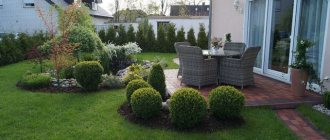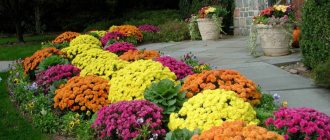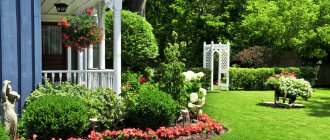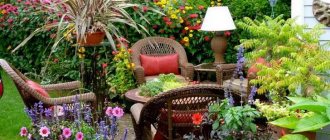Many owners of personal plots like to arrange them in their own way. A gazebo can be an excellent alternative to a veranda or terrace. You can relax, eat and breathe fresh air in it at the same time. And if you also arrange the surrounding landscape, you can fully enjoy the beauty of the garden. Arrangement of landscape design is a rather complex process from a creative and technical point of view, but it is quite possible to cope with it yourself.
The landscape emphasizes the recreation area, giving it beauty and comfort.
The best place for a gazebo
A quiet, shady place, maximally protected from bad weather, is suitable for a gazebo. It is important that it offers a beautiful view of the surrounding nature. Often buildings are erected on a hill to protect them from moisture, near flower beds and ponds.
The pond located near the gazebo gives coolness and peace.
A great idea would be to surround the building with a monogarden or rose garden, hedges, coniferous or climbing plants. This will help isolate people relaxing in the gazebo from noise and road dust, as well as protect them from the sun.
The place for the gazebo is selected in accordance with the location of the house. Both buildings should be at the same level, or the gazebo should be at the level of the first floor of the house.
A large number of green spaces and neat paths with carefully trimmed bushes will give the site a well-groomed appearance.
Decorative grilles
To make it easier for climbing plants to weave through the walls as they move upward, install decorative trellises or plastic nets of the appropriate color. In the meantime, while the lashes are “climbing” up, you can decorate the walls of the gazebo with hanging vases, flowerpots or boxes with fragrant plants and herbs. Lavender, petunia, dicentra, marigolds will create comfort and lift your spirits.
Design ideas for a gazebo
One of the simplest elements in the design of a garden building is carving. It is quite possible to do it yourself. Carvings decorate window openings or supporting pillars of a structure.
Gazebos with barbecues can be built in different styles, depending on the preferences of the owners. The design is in the form of a light building with a barbecue and a spacious dining area - an excellent option for those who love simplicity. A capital building with dedicated areas for cooking and relaxation - for those who don’t mind the time and effort to arrange a garden building.
A gazebo with a cooking area is not only beautiful, but also practical.
When drawing up a project, you should pay attention not only to aesthetics, but also to the functionality of the future building. There should be enough space inside to accommodate a table and chairs.
Light shadow
Over time, vines planted along the resting place can tightly tighten the walls and top of the structure, loading the structure with considerable weight and deforming it. Therefore, it is necessary to periodically thin out their crown.
If you want the shadow not to be dense, but, on the contrary, light and openwork, plant cultivated grape varieties. Then, when the breeze blows, the rays of the sun will penetrate into the cool corner, creating the effect of a lace curtain.
Video: An example of planning a landscape around a gazebo
The following recommendations will help you avoid mistakes when designing landscape design in your garden:
- The gazebo should be located at a distance of at least 3 meters from the reservoir. This will prevent mosquitoes from appearing in the evening and prevent the wood from rotting from moisture.
- The area should be well lit. Lights are required along the paths and near the gazebo itself. Motion sensors will reduce energy consumption. Beautiful lighting will give the garden a festive look.
- When arranging the landscape around a garden building, you should take into account the type of soil. Sandy or clay soil is suitable for oriental-style designs. Here you can build a dry pond, plant bonsai, or make a stone alpine slide. If the soil is moist, then you can safely choose country or Provence style decor.
It is important to create harmony in the garden plot. The gazebo, house and surrounding areas should have the same style.
A gazebo can serve as a frame for green spaces. This design is especially appropriate if the building is located in an open area and needs to be protected from the sun.
Decorating a gazebo with climbing plants is the most affordable, beautiful and practical way to decorate.
If the design does not provide for the possibility of using climbing plants, then you can simply plant shrubs or ornamental or fruit trees around the perimeter of the gazebo.
Different types of flowers
When selecting planting material, pay attention to the period and duration of flowering of crops. Combine different types that will differ in terms of flowering, then throughout the entire summer period the decoration of the summer terrace will be varied and will definitely not get boring. A pleasant floral aroma will delight you from early spring to late autumn.
Oriental design in a gazebo
Oriental style implies minimalism and a clear idea of what each detail in the interior will symbolize. Many elements can be made by hand.
A stone garden and a sandy stream mean calm and tranquility during relaxation.
Eastern style is created according to the following rules:
- Minimum of small details.
- Place color accents on several original things, such as compositions or sculptures.
- Near the gazebo you can make a stream of stones and sand. It has a calming effect and promotes relaxation.
- Bonsai can be planted around the building, especially if the soil topography is hilly.
- Round lamps and decorative lanterns.
- Flowerbeds are laid out with stones.
- Metal figured elements.
- Strict geometric shapes.
- Lack of stucco and abundant decor.
A gazebo in an oriental style is a mystery, subtlety of style, charm and enchantment.
Making flower beds with your own hands
You don’t have to spend a lot of money to create a well-groomed flower garden. Leftover building materials and empty containers are perfect for decorating a flowerbed with your own hands.
Beautiful flower beds and original decor at the dacha
Straight flowerbed at the dacha
Flowerbed from a barrel at the dacha
Original flower beds made from tires
It’s hard to surprise with flower beds made from old tires. However, it must be admitted that this is a very convenient option for a handy container for growing flowers.
A common decorative technique is to paint tires in different shades. Large wheels are used as independent flower beds (planted with dahlias, phlox), and small products are laid in different ways. Cascade-type plants are planted in them - pelargonium, petunia.
Beautiful compositions made of wood
Cheerful flower beds arranged in sawn logs will naturally fit into the landscape. To create a composition of branches, stumps (rutaria), bright flowers and plants with lush green foliage are selected. The log can be painted, but it is better to emphasize the natural texture of the wood with varnish.
Natural flower garden containers made from scrap materials
Flowerbed of succulents in the country
Flowerbed in a pot at the dacha
Flowerbed from a stump at the dacha
Bottle options
The main advantages of the material are accessibility and the ability to fence off an area of any shape and size. The simplest design option is to bury the bottles with the neck down.
An additional decoration is the color of the plastic. Although some summer residents specifically paint the bottom of plastic bottles.
Flowerbed of cacti at the dacha
Beautiful flower bed around a tree
This way you can decorate part of the house or garage
Exterior elements made of stones
Flat stones, rounded cobblestones, and granite are suitable for decorating flower beds and beds. Step-by-step instructions for creating a flower bed:
- outline the shape;
- stones are laid on top of each other along the perimeter to the required height;
- Cement is used to fix the elements.
Tall plants are planted in the flowerbed, otherwise the low ones will simply be invisible.
Flowerbed with stone walls - a durable flower garden
Unusual options from old furniture
At the dacha, all materials and junk items are used. Setting up a flower garden from furniture: drawers are pulled out at the chest of drawers and secured at the desired level. Containers with flowers are placed in the compartments. A creative option is to cut out the seat of the chair and place a large flowerpot at the base.
Flowerbed of tulips at the dacha
Round flowerbed at the dacha
Beautiful flower bed on an old cart in the country
Other original form ideas
Unusual flower beds are created using building materials (slate, asbestos-cement sheets, brick). Borders make it easier to care for the flower bed.
Original ideas for decorating flower beds and flower beds at your dacha with your own hands - using unnecessary equipment. The old bicycle is fixed and the whole thing is painted in a bright color. Flowerpots with flowers are placed behind the seat and in front of the steering wheel.
Mobile flower bed made from old equipment
Country style in the garden
It's a little more difficult to recreate. It is not enough to simply install a couple of ethnic elements on the site - a cart, a fence and arrange flower beds with a colorful variety of flowers.
The folk style is recreated according to the following rules:
- Decorative items are selected so that they match each other in color and texture. If wicker is chosen as the central element, then the furniture should also be wicker. Lattices, wicker decorations and carvings on the gazebo itself will complete the composition.
- Several flower beds with bright flowers for accents.
- The use of natural materials - stone, wood, wicker, clay, linen fabrics.
A gazebo in a folk style takes us back to childhood, reminds us of our roots, and strengthens our spirit.
It is important to observe the measure in the number of objects and decorative details. Don't use too many bright colors.
Easy care
If you visit your dacha on a sporadic basis and don’t have the time or opportunity to care for the plantings, hops or Amur grapes would be an excellent solution. These vines do not require careful care, but do an excellent job of decorative shading.
When distributing landscape plantings near the gazebo, do not forget to take into account the ease of movement in the surrounding area and take care of the paths. You can also plant low ornamental shrubs or annual flowers along the paths.
Source of the article: https://babushkinadacha.ru/interesnoe/kak-ukrasit-prostranstvo-vokrug-besedki.html
Vegetation around the garden building
Often, garden gazebos and verandas are decorated with hanging plants. They have long, flexible, curly shoots that tend upward or spread along the ground.
Flowers are placed at different levels both inside the building and outside in pots or cache-pots, as well as simply in the garden bed. Near the entrance there are low-growing plants, and in the background, on the contrary, there are vines and tall shrubs.
If climbing plants are properly cared for, they will grow over time and cover the building with a continuous carpet.
The basic rules for landscaping a gazebo are as follows:
- You shouldn't use too many different types of plants, one or two is enough. At the same time, they should fit well with each other.
- In the flower beds near the gazebo, it is best to plant plants that bloom at different times, then the building will always be surrounded by flowers.
- For climbing plants, trellises should be installed to allow them to climb and grow upward.
The most popular climbing plants are wild grapes and ivy, and the most popular flowering plants are roses and clematis.
A gazebo covered with ivy or flowers does not need additional decor; it already looks presentable.
Climbing plants not only give beauty and coolness, but also hide from prying eyes.
What plants to plant
Flowers are most suitable for open garden pavilions. Both annual and perennial flowers can be planted near them. Ampelous plants in flowerpots look gorgeous. The buildings surrounded by flowers look luxurious. The easiest way is to simply hang flowerpots and arrange containers with plants.
Curly
A climbing rose wrapped around the frame of a gazebo looks romantic and elegant . Varieties can be very different: climbing ones with large flowers, standard ones, ramblers with flexible shoots. These bushes are quite resistant to wind and bad weather. You will especially appreciate varieties with a delicate aroma. You can plant one bush on each side.
Another favorite of gardeners is the shade-loving ivy. By braiding the frame of the building, it turns into a continuous green carpet. In addition, it can be spread on the ground, planted in flowerpots or pots. Honeysuckle and maiden grapes entwine the structure perfectly.
Important! Vertical landscaping of the gazebo will advantageously hide the flaws of the building.
If you want to create a light openwork shadow so that the sun’s rays penetrate through the foliage, then it is appropriate to plant cultivated grapes next to the structure. In addition to the leaves, at the end of summer there will be ripe grapes hanging beautifully on it. For the northern regions, this option is not entirely suitable due to freezing of the bushes.
Recently, gardeners have fallen in love with the most beautiful subtropical plant - wisteria . She is afraid of frost, but one variety (Blue Moon) can withstand cold temperatures down to -40°C. Wisteria very beautifully entwines the structure, and during flowering it pleases with delicate bluish inflorescences.
Another perennial vine is clematis . Flower colors come in a variety of colors: purple, pink, cherry, blue. The plant loves a lot of sunlight; in the shade it blooms poorly and grows slowly. Tie stems and skeletal branches to trellises or other supports.
If you don't like flowering vines, you can plant herbaceous climbing hops . The bush renews itself every spring and covers an area of several meters. In addition to these plants, the gazebo can be decorated with common ivy, morning glory, sweet peas, and actinidia.
Did you know? In Russia, an example of such buildings are the gazebos of Peterhof and Tsarskoe Selo. The pavilion in the garden of the Mikhailovsky Palace (St. Petersburg) is magnificent.
For flower beds
Near the gazebo you can set up alpine slides and a flower bed. The farther from the structure, the lower you plant the plants . This way they will all be clearly visible. Plant fragrant flowers near the building itself: sweet peas, mock orange, petunias, carnations, white tobacco. Select crops in accordance with the duration and timing of flowering, and then the gazebo will be filled with a pleasant aroma all summer.
The area near the country pavilion can be decorated with potted plants in hanging pots or on shelves . Suitable annuals include nasturtium and decorative beans. You can plant begonia, verbena, and ampelous pelargonium in flower boxes.
It is not enough to build a beautiful gazebo on your plot; it is also important to decorate it effectively. It will be better if you use perennial climbing plants for this. In a few years they will reach a sufficient height and will resemble a solid decorative wall.
Gazebo decor
The most suitable material for decorating a gazebo is wood. They are appropriate in many styles, look very natural and go well with the plants around the building.
Wood is an environmentally friendly material, practical and aesthetic. Typically, coniferous trees such as pine or oak are used for gazebos. The wood must be coated with protective solutions to prevent damage. Special products will help give it the desired shade.
The roof for the gazebo can be made of tiles, polycarbonate or the same wood. The floor can be tile, wood or stone. It’s good if it matches the paths or borders in the garden and is made of the same material.
Decorating a gazebo with wood is always stylish, beautiful, and environmentally friendly.
The inside of the gazebo can also be lined with wood or plywood and flowering climbing plants can be used as decoration.
To design your summer cottage, you can use all your imagination, but we must not forget about the rules of landscape design. Then the gazebo and the surrounding areas will look harmonious and beautiful. The design of the gazebo is the most important part of the decorative design of the garden plot. The more original it is, the more attractive the landscape of a country house.
Planning
Decide what plants and where you would like to plant. It would be more practical and durable to do a combined planting of annual and perennial crops. Once you have decided what exactly will grow near your gazebo, start selecting plants.
Tall shrubs and decorative vines are usually planted near the walls of the gazebo itself. The first year you can cover the walls and roof with annual climbing plants - they grow quickly and provide an excellent background, shading and creating the upper level of the background of the entire landscape.
Pergola: design features
If you try to accurately define the meaning of the term “pergola”, then it is a structure consisting of several arched sections connected by crossbars. This can be either an extension to the house, or a connecting passage between two buildings, or a separate structure.
- A couple of centuries ago, when pergolas just became fashionable, they were placed as a support for climbing grape shoots - and at the same time, in their shade one could hide from the scorching sun. Today it is a beautiful architectural element used in landscape design.
Modern pergola
- A pergola can be a permanent structure, built not only from metal rods or wooden beams, but also from stone, brick and concrete. They are simple in design, give a feeling of spaciousness, and the cost of construction is significantly reduced due to the absence of vertical fences.
- A distinctive feature of pergolas is the perforated roof, which allows the sun's rays to pass through and at the same time screens them. Regardless of what material the pergola posts are constructed from, boards installed on edge are used to create its roof. They can be positioned strictly vertically or, similar to blinds, at an angle. Their length is oriented east-west.
Pergola with climbing plants on the terrace in front of the house
- In this case, in the morning and evening, the rays of the sun penetrate unhindered between the boards, and at noon, partial shade appears under the roof. To avoid creating an oppressive atmosphere, the height of the pergola should be at least 2.8 m, and if it is intended to be decorated with climbing plants, then more. Often, a perforated roof is protected from rain using transparent polycarbonate (see Polycarbonate gazebo roof: what is the difference from other materials), which is laid on top of the boards.
A pergola-gazebo looks most impressive when it is made in the style of the main building - especially if it is an extension. The overwhelming majority are built from wood, and therefore we will adopt this option.
Modern
The style of modern gazebos is sharply different from those that we are used to seeing in summer cottages and villages. Fashion is dictated for the most part by European countries with a good climate, where you can put electrical equipment in an open room and, in general, feel quite calm.
I really like the Italian style - light, free and simple. However, in Russian climatic conditions it is almost impossible to implement it.
I won’t go into too much detail about the advantages of such architectural masterpieces, because ultimately it all comes down to whether this option can be implemented in your backyard. If this is possible, then you need to boldly take the idea and use it in construction. And if not, then continue looking for a simpler and more reliable option.











